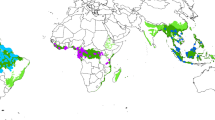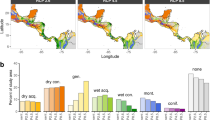Abstract
Spatial patterns of conspecific trees are considered as the consequences of biological interactions and environmental influences. They also reflect species interactions in plant communities. However, biological attributes are often neglected while deliberating the factors shaping species distributions. As rising attentions are paid to spatial patterns of tropical forest trees, we noticed that seven Center of Tropical Forest Sites and four Forest Dynamic Plots in Asia and America have presented analogously high proportions of species with aggregated conspecific individuals coincidently. This phenomenon is distinctive and repudiates fundamental ecology hypotheses which suggested dispersed distributions of conspecific tropical trees due to intensive density and natural enemy pressures in tropical forests. We believe that similar aggregation patterns shared by these tropical forests implies the existence of structuring forces in biogeographical scale instead of habitat heterogeneity in local community scales as scientists have considered. To approach the factors contributing to this cross-continent spatial pattern of trees, we obtained and reviewed ecosystem attributes, including topography, temperature, precipitation, biodiversity, density, and biomass, of these forests. Here we show that the proportions of aggregated species are actually constants independent of any ecosystem attributes regardless the nature of these tropical forests. However, local biodiversity are the major factor determining the number of aggregated species and the aggregation of large individuals of these forests. Aggregation of large trees declines along rising biodiversity, while the numbers of aggregated species increase permanently along lifting biodiversity. We propose a possible equilibrium and saturated status of the tropical forests in accommodating aggregated species. Furthermore, the tight correlations of biodiversity and species aggregation strongly imply the importance of overlooked biological interactions in shaping the spatial patterns in the tropical forests.
Similar content being viewed by others
Article PDF
Author information
Authors and Affiliations
Corresponding author
Rights and permissions
About this article
Cite this article
Wu, SH., Chao, WC. & Hsieh, CF. Biodiversity shapes tree species aggregations in tropical forests. Nat Prec (2008). https://doi.org/10.1038/npre.2008.1670.1
Received:
Accepted:
Published:
DOI: https://doi.org/10.1038/npre.2008.1670.1



